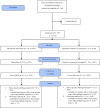Steps Towards Alcohol Misuse Prevention Programme (STAMPP): a school-based and community-based cluster randomised controlled trial
- PMID: 29525770
- PMCID: PMC5879538
- DOI: 10.1136/bmjopen-2017-019722
Steps Towards Alcohol Misuse Prevention Programme (STAMPP): a school-based and community-based cluster randomised controlled trial
Abstract
Objectives: To assess the effectiveness of a combined classroom curriculum and parental intervention (the Steps Towards Alcohol Misuse Prevention Programme (STAMPP)), compared with alcohol education as normal (EAN), in reducing self-reported heavy episodic drinking (HED) and alcohol-related harms (ARHs) in adolescents.
Setting: 105 high schools in Northern Ireland (NI) and in Scotland.
Participants: Schools were stratified by free school meal provision. Schools in NI were also stratified by school type (male/female/coeducational). Eligible students were in school year 8/S1 (aged 11-12 years) at baseline (June 2012).
Intervention: A classroom-based alcohol education intervention, coupled with a brief alcohol intervention for parents/carers. PRIMARY OUTCOMES: (1) The prevalence of self-reported HED in the previous 30 days and (2) the number of self-reported ARHs in the previous 6 months. Outcomes were assessed using two-level random intercepts models (logistic regression for HED and negative binomial for number of ARHs).
Results: At 33 months, data were available for 5160 intervention and 5073 control students (HED outcome), and 5234 and 5146 students (ARH outcome), respectively. Of those who completed a questionnaire at either baseline or 12 months (n=12 738), 10 405 also completed the questionnaire at 33 months (81.7%). Fewer students in the intervention group reported HED compared with EAN (17%vs26%; OR=0.60, 95% CI 0.49 to 0.73), with no significant difference in the number of self-reported ARHs (incident rate ratio=0.92, 95% CI 0.78 to 1.05). Although the classroom component was largely delivered as intended, there was low uptake of the parental component. There were no reported adverse effects.
Conclusions: Results suggest that STAMPP could be an effective programme to reduce HED prevalence. While there was no significant reduction in ARH, it is plausible that effects on harms would manifest later.
Trial registration number: ISRCTN47028486; Post-results.
Keywords: adolescents; alcohol; alcohol related harm; prevention; school based intervention; universal prevention.
© Article author(s) (or their employer(s) unless otherwise stated in the text of the article) 2018. All rights reserved. No commercial use is permitted unless otherwise expressly granted.
Conflict of interest statement
Competing interests: The sponsor university (LJMU) received and administered a payment from the alcohol industry for printing of student workbooks in the Glasgow trial site only. AP reported that he has previously received funding from the European Foundation of Alcohol Research (ERAB) in relation to the development of statistical models for longitudinal data (2008–2010). DF reported that his department has previously received funding from the alcohol industry for unrelated prevention programme training work. HS reported that his department has previously received funding from the alcohol industry (indirectly via the industry funded Drinkaware charity) for unrelated primary research.
Figures


Similar articles
-
Cost-effectiveness of a combined classroom curriculum and parental intervention: economic evaluation of data from the Steps Towards Alcohol Misuse Prevention Programme cluster randomised controlled trial.BMJ Open. 2019 Jul 2;9(7):e027951. doi: 10.1136/bmjopen-2018-027951. BMJ Open. 2019. PMID: 31270116 Free PMC article. Clinical Trial.
-
Steps Towards Alcohol Misuse Prevention Programme (STAMPP): a school- and community-based cluster randomised controlled trial.Southampton (UK): NIHR Journals Library; 2017 Apr. Southampton (UK): NIHR Journals Library; 2017 Apr. PMID: 28406601 Free Books & Documents. Review.
-
An Examination of the Longer-Term Impact of a Combined Classroom and Parental Intervention on Alcohol-Related Harms and Heavy Episodic Drinking.Prev Sci. 2021 May;22(4):443-451. doi: 10.1007/s11121-020-01193-5. Epub 2021 Jan 12. Prev Sci. 2021. PMID: 33433820 Clinical Trial.
-
Disentangling the temporal relationship between alcohol-related attitudes and heavy episodic drinking in adolescents within a randomized controlled trial.Addiction. 2025 Apr;120(4):645-654. doi: 10.1111/add.16721. Epub 2024 Dec 10. Addiction. 2025. PMID: 39657732 Free PMC article. Clinical Trial.
-
Whole-of-community interventions to reduce population-level harms arising from alcohol and other drug use: a systematic review and meta-analysis.Addiction. 2018 Nov;113(11):1984-2018. doi: 10.1111/add.14277. Epub 2018 Jul 5. Addiction. 2018. PMID: 29806876
Cited by
-
Cost-effectiveness of a combined classroom curriculum and parental intervention: economic evaluation of data from the Steps Towards Alcohol Misuse Prevention Programme cluster randomised controlled trial.BMJ Open. 2019 Jul 2;9(7):e027951. doi: 10.1136/bmjopen-2018-027951. BMJ Open. 2019. PMID: 31270116 Free PMC article. Clinical Trial.
-
Parental health risk preferences, socio-economic status and offspring's alcohol behavior in South Africa.Heliyon. 2024 Jun 24;10(13):e33517. doi: 10.1016/j.heliyon.2024.e33517. eCollection 2024 Jul 15. Heliyon. 2024. PMID: 39040230 Free PMC article.
-
Recanting of Previous Reports of Alcohol Consumption within a Large-Scale Clustered Randomised Control Trial.Prev Sci. 2019 Aug;20(6):844-851. doi: 10.1007/s11121-019-0981-2. Prev Sci. 2019. PMID: 30637672 Free PMC article. Clinical Trial.
-
Piloting of the Just Say Know prevention program: a psychoeducational approach to translating the neuroscience of addiction to youth.Am J Drug Alcohol Abuse. 2021 Jan 2;47(1):16-25. doi: 10.1080/00952990.2020.1770777. Epub 2020 Jul 20. Am J Drug Alcohol Abuse. 2021. PMID: 32687415 Free PMC article.
-
Brief interventions to prevent excessive alcohol use in adolescents at low-risk presenting to Emergency Departments: Three-arm, randomised trial of effectiveness and cost-effectiveness.Int J Drug Policy. 2021 Jul;93:103113. doi: 10.1016/j.drugpo.2021.103113. Epub 2021 Jan 22. Int J Drug Policy. 2021. PMID: 33487528 Free PMC article. Clinical Trial.
References
-
- Bellis MA, Morleo M, Hughes K, et al. . A cross-sectional survey of compliance with national guidance for alcohol consumption by children: measuring risk factors, protective factors and social norms for excessive and unsupervised drinking. BMC Public Health 2010;10:8 10.1186/1471-2458-10-547 - DOI - PMC - PubMed
Publication types
MeSH terms
Associated data
LinkOut - more resources
Full Text Sources
Other Literature Sources
Medical
